|
Published February 15, 2024
Last updated on June 22, 2024 How to chant the Liturgy of the Hours I imagine most people reading this have already prayed the Liturgy of the Hours (a.k.a. Divine Office, a.k.a. the Breviary) in digital form on an electronic device. The three most popular digital breviaries are The Divine Office, iBreviary and Universalis. These websites and their corresponding apps are so convenient with no page flipping, no ribbons, and no worries of praying the wrong contents on special days. You can also pray outside in the early morning or late evening when there is not enough sunlight to read a book. And as you get older, the ability to increase the font size is a very welcome feature. I admit that I have always preferred physical books and have invested a bit of money in various breviaries and four-volume sets, but these digital advantages had been wearing down my resistance. Then I discovered the split screen feature on both Android tablets and iPads, and that was the tipping point. The reason is that now I can have a reference open next to my digital breviary such as a sheet of notation for chanting the Psalms. Since I currently use an iPad, I will describe my experience with that particular tablet, although everything I write can also apply to an Android tablet. For more information on the Saint Meinrad Psalm Tones and related resources see my article, Some resources for singing the St. Meinrad Psalm Tones with the Liturgy of the Hours. For those who prefer Gregorian Chant, see my article called How to chant the Liturgy of the Hours with Gregorian Chant and a digital breviary. Here is the iBreviary app in the left window next to a PDF of the Saint Meinrad Psalm Tones as it looks on my iPad: 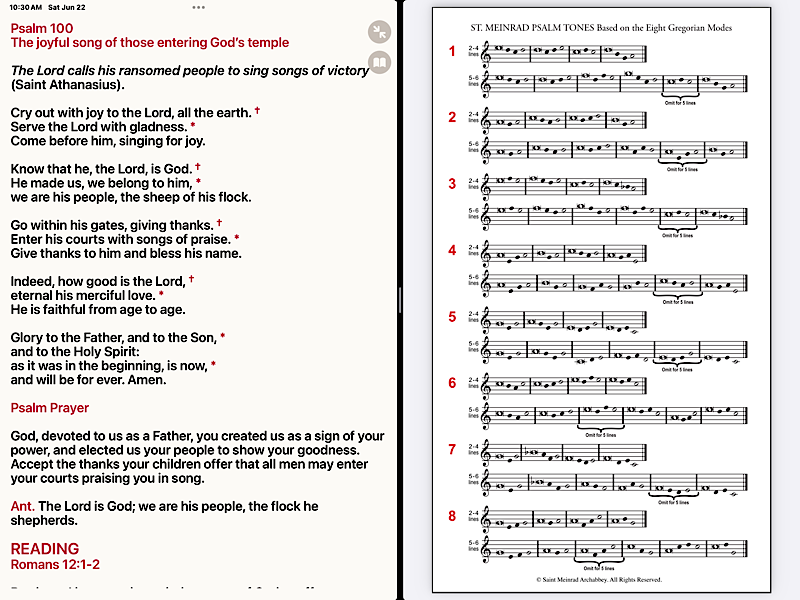
Here is the Universalis app in the left window: 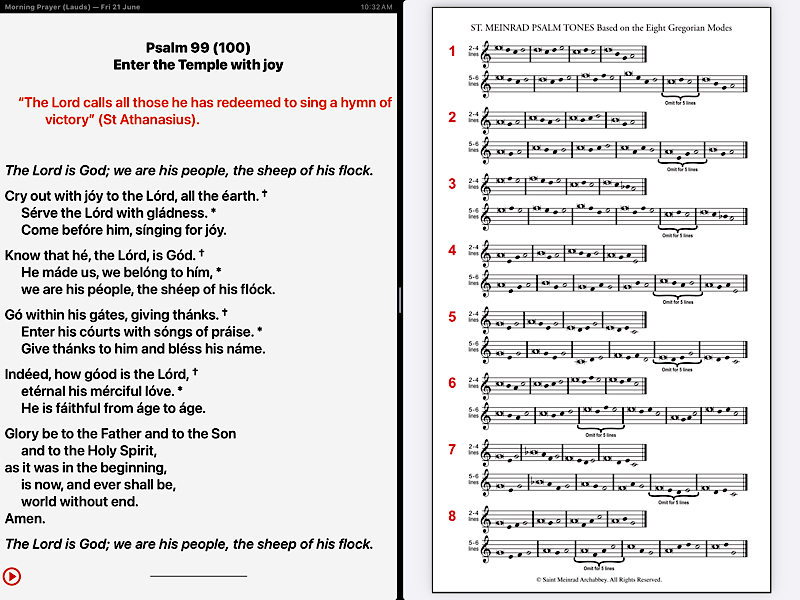
Here is the iBreviary app with a PDF chart which assigns a Psalm Tone to each Psalm: 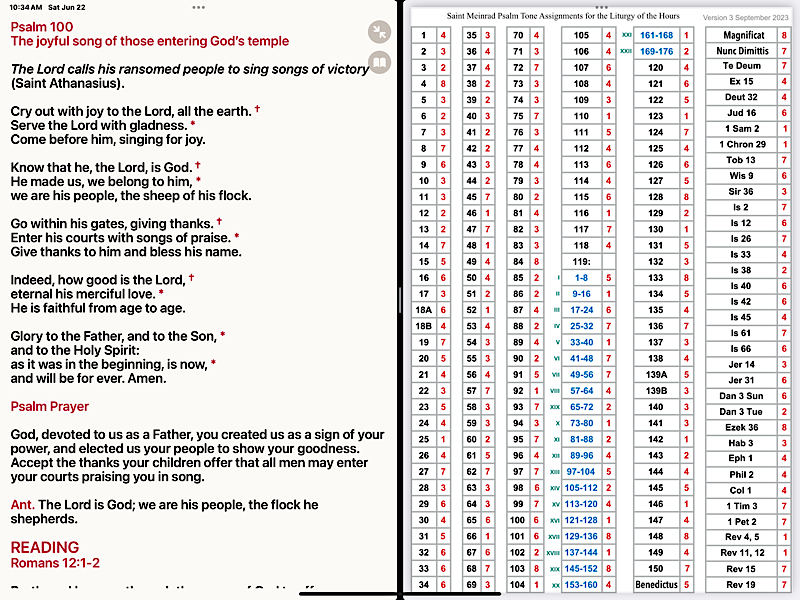
Here is the same PDF chart with the Universalis app: 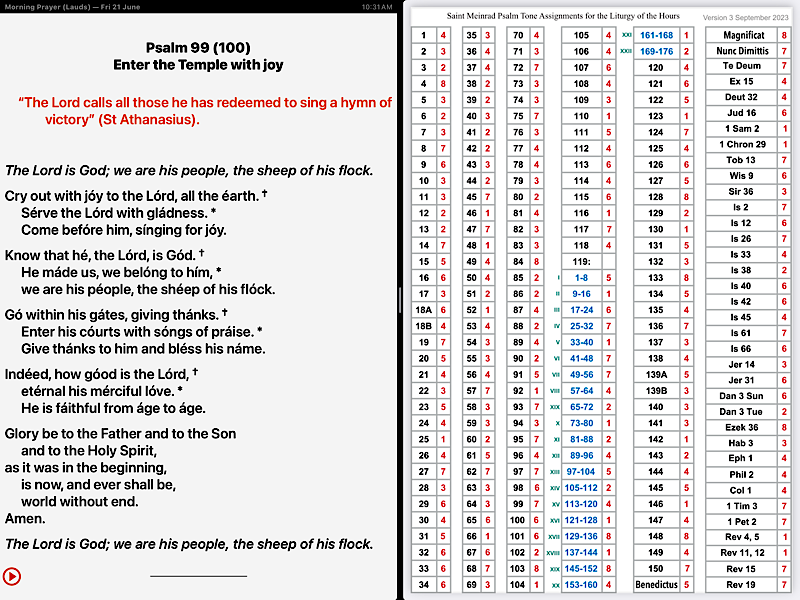
And here is the iBreviary app with a PDF chart that shows which Psalms are used with each of the Hours in the Liturgy of the Hours: 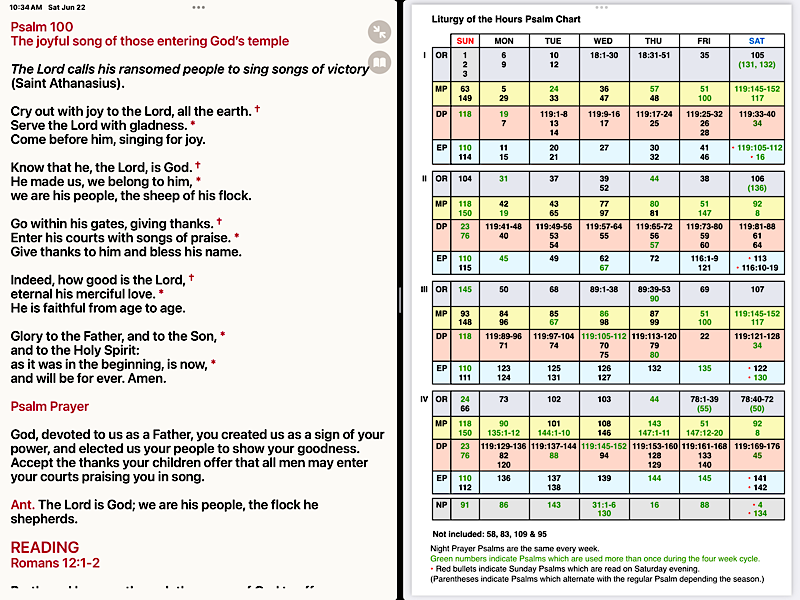
Here is the same PDF chart with the Universalis app: 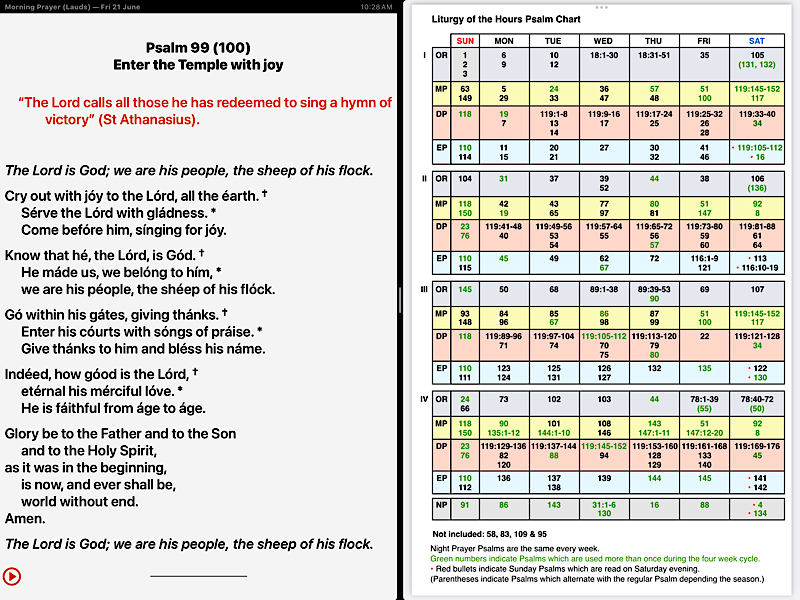
These screenshots show the iBreviary and Universalis apps and the rather than the websites, but the websites also work well with split screen. As of this time, The Divine Office app does not support the split screen feature, while the Divine Office website does. Here is how the split screen looks with the Divine Office website: 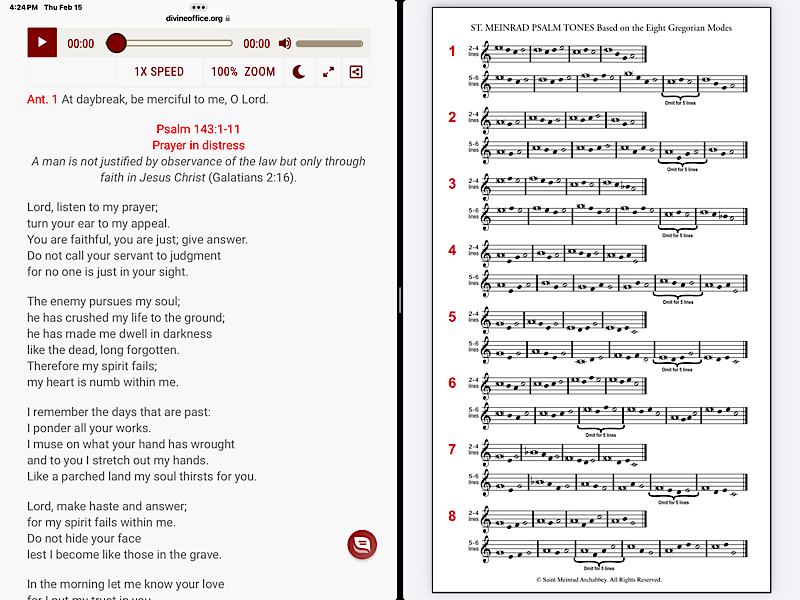
However, those outside the U.S. will be blocked from using the Divine Office website. So for those people only the iBreviary or Universalis websites will work with split windows. If other Liturgy of the Hours websites exist, they will probably also work with a split window. I should note that although I live in Tokyo, I am able to access the Divine Office website. I figure this is either because I actually paid for the app many years ago and have had access to the website all this time with my user name and password, or because I don't allow the website to use my actual location whenever I visit now. Chant or recite the non-Psalms? While the Psalms were written as songs to be sung, many other parts of the Liturgy of the Hours are a bit awkward to sing, including some canticles, because they were not originally written as songs. This especially goes for the New Testament canticles in Evening Prayer which were written to communicate crucial truths, but not necessarily intended to be sung (and some are even difficult to sing). I sometimes choose to recite the non-Psalm canticles rather than sing them because the meaning comes through more clearly if I don't break up the sentences midway to force them into a tune. What about the hymn? It might seem odd to chant the Psalms, but merely say the hymn because you don't know the tune. If you are praying the Liturgy of the Hours with either iBreviary or Universalis then you are in luck because on most days they have a hymn that is written in Long Meter. In iBreviary if you scroll to the end of a hymn you will see the tune's name followed by the letters LM or the numbers 8 8 8 8. An example of Long Meter is the Doxology or Old 100th (Praise God from whom all blessings flow...). I have two personal favorite Long Meter tunes which work very well with iBreviary and Universalis. One is Tallis' Canon and the other is Winchester New. Both of these are simple, dignified, and easy to remember. In case you don't know them, I have made simple mp3 piano demos of both: Lately I have been using a new Long Meter hymn which I had composed in the Pentatonic scale for the 7 string lyre. It's such a simple tune that I wouldn't be surprised if someone else has already come up with it. If you know of an earlier version of this, please let me know. But for now, since I need to give it a name, I've just attached my own name. Sometimes a hymn will appear in Common Meter which is followed by the letters CM or the numbers 8 6 8 6. Common Meter is perhaps more common than you realize. Here are some familiar tunes in Common Meter:
One of my favorite Common Meter tunes is St. Flavian which is very similar to Tallis' Canon. Here is a piano demo: St. Flavian An exellent web site which has samples many other tunes written in various meters is Seedbed Index of Meters & Tunes Which digital breviary is best for chanting the Saint Meinrad Psalm Tones? I will limit this comparison to the three most popular websites and their corresponding apps since I am most familiar with them. The iBreviary web site and app includes flexes and asterisks which are special symbols for navigation. They signal whether a stanza is divided into two or three lines, and make the Psalms easier to chant, especially in stanzas that have more than three lines and are not as easy to divide. The Universalis website does not have these symbols, but their app does. In addition, their app includes accent marks which are not included in iBreviary over the text of the Psalms. I recalled seeing similar accent marks in my copy of the Singing version of the Revised Grail Psalms. These accent marks help you to see the "sprung rhythm" of the Psalms which, according to the introduction of that book, "imitates natural speech patterns, designating a certain number of major accents per line, while having an unfixed number of unstressed syllables, with no more than four syllables between each foot." So the combination of flexes, asterisks and accent marks make Universalis app even more helpful for singing the Saint Meinrad Psalm Tones. However, the app is not free like iBreviary. The Divine Office website and app do not include any special symbols or accent marks, and website is only available to those who live in the United States. Which audio breviary is best? There are times when you might want to pray along with an audio version of the Liturgy of the Hours, such as when you are driving or exercising or washing the dishes. Of course, it would be difficult to chant Psalm Tones while listening to an audio version, so this part of the discussion is for times when you are using a digital breviary but chanting is not part of the picture. The iBreviary app will read the text to you aloud with its text-to-speech feature. And most computers, tablets or smart phones have text-to-speech that can "speak" the text of the iBreviary website. For some people that will be enough, and it's free. For those who want actual recordings of the text read by living humans the The Divine Office and Universalis offer that. The audio feature in The Divine Office is on their website for free, but as mentioned above, people living outside the United States are apparently blocked from using the website. The Universalis website does not have an audio feature, but one is available on their app by a paid subscription. The Divine Office audio version has their own music, and the narrators have a way of reading the text which is liked by some people and not by others. The Universalis audio version is a straight reading of the text with no music, and I prefer its dignified and natural style. As a matter of fact, I have found it quite possible to mentally add the Saint Meinrad Psalm Tones in the background, and chant the Psalms in my head. I also love the fact that I can choose the RSV-CE for scripture readings. So the combination of the Universalis app and its audio subscription has become my personal choice for the natural sounding audio, the symbols, the accents and the addition of the RSV-CE. It is well worth the small investment. Conclusion Granted, all prayer including the Liturgy of the Hours is serious work, and one should not be so concerned with the consolations or positive feelings that might or might come during prayer time. But we already know that music adds so much to the prayer experience, and the Psalms exhort us over and over to sing to God. So why not make it all a little more gratifying in the process? I've written more about the Liturgy of the Hours and Singing the Psalms in other articles. The best way to find them is to just go to my home page (assuming you came to this article directly through a web search) and scroll down to the Faith section. May God bless your efforts to bring music into your prayer life! |